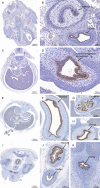From development to cancer - an ever-increasing role of AGR2
- PMID: 34873459
- PMCID: PMC8640830
From development to cancer - an ever-increasing role of AGR2
Abstract
Anterior gradient 2, AGR2, is a small, 20 kDa protein that plays a vital role in oxidative protein folding in the endoplasmic reticulum. AGR2 is involved in several signal transduction pathways that are essential for cell survival. It was initially discovered in the African clawed frog, Xenopus laevis, where it plays an important function in embryonic development. Akin to several other developmental genes, it is also frequently deregulated in cancer, where it plays a decisive role in tumor initiation, progression and metastasis. In this review, we have summarized currently known AGR2 functions, its expression and function in embryonic and cancer development, as well as its potential as a candidate tumor biomarker and promising new target for cancer immunotherapy.
Keywords: AGR2; anterior gradient 2; cancer; embryonic development; therapeutic target; tumor biomarker.
AJCR Copyright © 2021.
Conflict of interest statement
None.
Figures


References
-
- Petek E, Windpassinger C, Egger H, Kroisel PM, Wagner K. Localization of the human anterior gradient-2 gene (AGR2) to chromosome band 7p21.3 by radiation hybrid mapping and fluorescencein situ hybridisation. Cytogenet Cell Genet. 2000;89:141–142. - PubMed
-
- Tereshina MB, Ivanova AS, Eroshkin FM, Korotkova DD, Nesterenko AM, Bayramov AV, Solovieva EA, Parshina EA, Orlov EE, Martynova NY, Zaraisky AG. Agr2-interacting Prod1-like protein Tfp4 from Xenopus laevis is necessary for early forebrain and eye development as well as for the tadpole appendage regeneration. Genesis. 2019;57:e23293. - PubMed
-
- Aberger F, Weidinger G, Grunz H, Richter K. Anterior specification of embryonic ectoderm: the role of the Xenopus cement gland-specific gene XAG-2. Mech Dev. 1998;72:115–130. - PubMed
Publication types
Grants and funding
LinkOut - more resources
Full Text Sources
Miscellaneous
